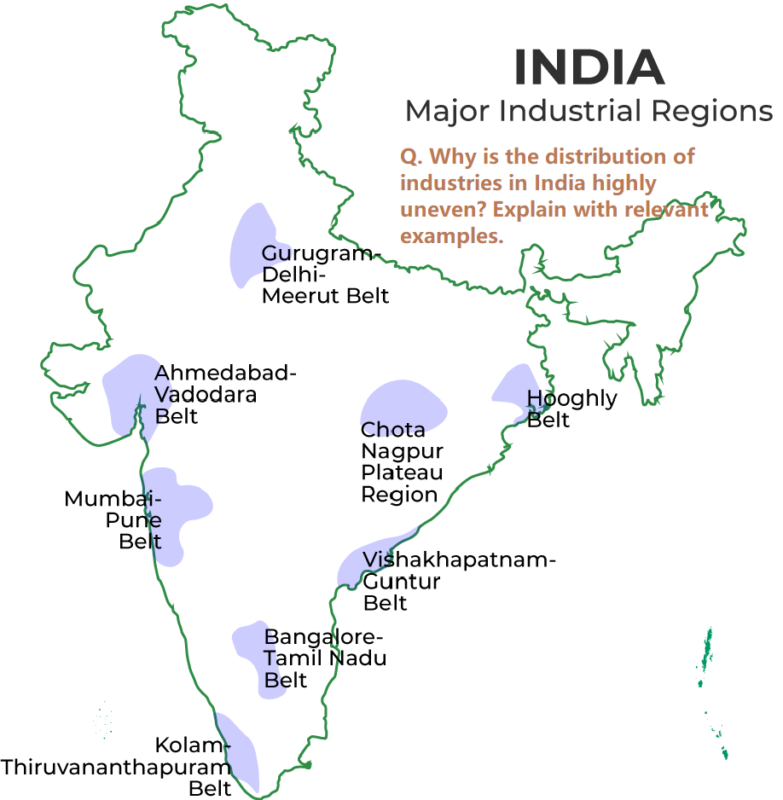The distribution of industries in India is highly uneven due to a combination of historical, geographical, economic, infrastructural, and policy-related factors. Here are the key reasons for this uneven distribution, illustrated with relevant examples:
1. Historical Factors
- Colonial Legacy: During British rule, industrial development was concentrated in certain regions to serve colonial interests. For instance, Mumbai (then Bombay) and Kolkata (then Calcutta) became major industrial hubs due to their ports and the establishment of industries like textiles and jute.
- Early Industrialization: Regions like Gujarat and Maharashtra benefitted from early industrialization due to enterprising communities and favorable conditions for trade and business.
2. Geographical Factors
- Resource Availability: Industries often develop in regions where raw materials are readily available. For example, the iron and steel industry is concentrated in states like Jharkhand, Odisha, and Chhattisgarh due to the abundant availability of iron ore and coal.
- Climate and Terrain: The climate and terrain also influence industrial distribution. For instance, the Western Ghats and the Himalayas, with their difficult terrain, have fewer industrial establishments compared to the plains.
3. Economic Factors
- Capital Availability: Regions with better access to capital and financial institutions attract more industries. Mumbai, being the financial capital of India, has a high concentration of industries.
- Market Proximity: Industries tend to be located near large markets to reduce transportation costs and ensure quick access to consumers. For instance, the National Capital Region (NCR) around Delhi has a high concentration of consumer goods industries.
4. Infrastructure
- Transport and Communication: Regions with better infrastructure, such as roads, railways, ports, and communication networks, attract more industries. Gujarat has developed a strong industrial base due to its well-developed port facilities and connectivity.
- Power Supply: Reliable and affordable power supply is crucial for industrial development. Regions with better access to electricity, like Tamil Nadu and Karnataka, have seen significant industrial growth.
5. Policy and Governance
- State Policies: Different states have different industrial policies, incentives, and ease of doing business, affecting industrial distribution. For instance, states like Gujarat and Maharashtra have proactive industrial policies and better governance, attracting more industries.
- Special Economic Zones (SEZs): The establishment of SEZs has led to industrial concentration in certain areas. For example, the SEZs in Andhra Pradesh and Telangana have attracted significant IT and manufacturing investments.
6. Labor Availability
- Skilled Workforce: Regions with a higher availability of skilled labor attract industries requiring specialized skills. For example, Bengaluru has become an IT hub due to the availability of a large pool of skilled IT professionals.
- Labor Costs: Industries also consider labor costs, leading to the establishment of labor-intensive industries in regions with lower labor costs. For instance, garment and textile industries are concentrated in Tamil Nadu and West Bengal.
7. Urbanization and Agglomeration Economies
- Urban Centers: Industrial development is often concentrated in and around urban centers, benefiting from agglomeration economies. Mumbai, Delhi, and Chennai are prime examples of urban centers with a high concentration of diverse industries.
- Industrial Clusters: The presence of industrial clusters fosters further industrial development due to shared facilities, services, and a skilled labor pool. For example, the automobile industry cluster in Pune and the textile cluster in Tirupur.
Examples of Uneven Industrial Distribution
- Mumbai-Pune Industrial Belt: This region has a high concentration of industries, including textiles, chemicals, automobiles, and IT, due to factors like port facilities, financial institutions, skilled labor, and favorable policies.
- Chota Nagpur Plateau: Rich in mineral resources, this region in Jharkhand, Odisha, and Chhattisgarh has a high concentration of heavy industries like iron and steel, aluminum, and mining.
- Gujarat Industrial Corridor: Gujarat has emerged as a major industrial hub with industries in chemicals, petrochemicals, textiles, and engineering due to its strategic location, port facilities, and business-friendly policies.
- Bengaluru: Known as the “Silicon Valley of India,” Bengaluru has a high concentration of IT and technology industries, driven by the availability of a skilled workforce, research institutions, and a conducive environment for startups.
Conclusion
The uneven distribution of industries in India is the result of a complex interplay of historical, geographical, economic, infrastructural, policy, and social factors. While some regions have naturally developed into industrial hubs due to favorable conditions, others lag behind due to various constraints. Addressing these disparities requires targeted policies and investments to promote balanced regional development.


